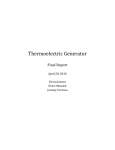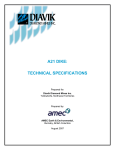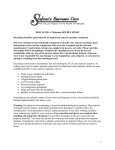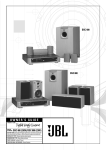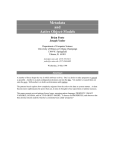Download System Design & Project Plan
Transcript
Wood Burning Generator System Design & Project Plan Kevin Jensen Drew Messick Jeremy Verzosa Table of Contents System Design……………………………………………………………………….…………………………………………………..………….3 Background……………………………………………………………….………………………………………….………………….4 System Overview…………………………………………………….….…………………………………………………………….5 Block Diagram……………………………………………………….……………………………………………………….…………6 Functional Description of Blocks………………………….…………………………………………………………….……..7 Project Plan…………………………………………………………………….………………………………………………….………………….9 Organization and Management………………………….……………………………………………………………………10 Estimated Costs………………………………………………….……………………………………………………………………11 Work Breakdown Structure (Fall 2009) …………….………………………………………….…………………………12 Work Breakdown Structure (Spring 2010) ……….………………………………………..……………………………13 Gantt Chart (Fall 2009) ……………………………………………………………………………………………………………15 Gantt Chart (Spring 2010) …………………………………………………………………………………………………….…16 Network Diagram (Fall 2009) …………………………………….……………………………………………………………17 Network Diagram (Spring 2010) ………………………………….……………………….…………………………………18 Appendices………………………………………………………………………………………………………………………….…………….…19 Appendix A: Budget References……………………………………………………….………………………………….…20 Appendix B: Requirements Specification…………………….……….…………………………………………………22 2 System Design 3 Background There is a large interest in today’s market for sustainable energy. Consumers are looking for devices that can provide electricity to their home, not only when power is unavailable but also in addition to their normal usage. The trouble with most products is that they are complex, bulky and expensive. Additionally, energy sources for these generators are not always available (wind/solar/fossil fuels). What is needed is a low cost, storable, easy to use device that provides supplemental energy to the home or emergency electricity if the power is out. We believe that a generator utilizing a wood fire in an existing fireplace as the energy source is the natural solution. The major benefit of this generator is that the combustion chamber is already available and safe, users know how to use it, and fuel is readily available. Our device will fill these requirements by being relatively inexpensive when compared to other sustainable energy products, small enough to easily store and transport and simple to use. If the user already burns fires in the home for heating or otherwise, this device’s fuel will come at no extra cost. The energy will simply come from the excess heat that is generally lost during wood burning. The generator will only be able to run or charge electrical devices that require less than 200 watts of power. Devices that require more power will not be supported. 4 System Overview Our project will provide power to a standard household outlet (NEMA Type B) utilizing a wood burning fireplace. The device will consist of a main generator box which will sit on the hearth outside of the fireplace along with a heat pipe that extends into the fire. The main generator will fit into a rectangular space no larger than 0.6 x .0.6 x 0.46 meters (approximately the size of a laundry basket) and weight less than 22.7 kg (50 lb). These dimensions will allow the device to be easily transportable and storable by a single person. The main generator will also house the user interface consisting of an on/off switch, a power indicator and the power outlet. The power indicator will let the user know when the device is generating enough electricity for the outlet to be used. When in use, the main generator will collect heat from the fire via a gravity return heat pipe (sometimes known as a thermosyphon). This heat pipe will transport the heat away from the fire and to the main generator sitting on the hearth. Inside the main generator, several thermoelectric generators will utilize the temperature differential between the provided heat and a cooling device. These thermoelectric generators will provide a DC voltage which will be sent to an inverter to convert it to the required output. The power indicator will analyze this output and, if it is sufficient, notify the user. A backup battery will also be charged using the DC voltage in order to supplement the output as the temperature of the fire fluctuates. In order to set up and use the generator the user will first place the device on the hearth to the right of the fireplace (aligning the turn in the heat pipe with the right edge of the fireplace) and build a fire. Using their poker or a provided tool the heat pipe will then be positioned on top of the burning wood. The user will then wait until the power indicator lights up. Once this has happened, the user may turn on the switch and plug in a device. When it is time for more wood to be added to the fire, the user will move the heat pipe (using the poker or provided tool) and add more logs. When this is complete, the heat pipe will be again positioned on top of the burning logs. The heat pipe remains in the fireplace during this entire time, but will either be pushed to the back or pulled to the front out of the way of the new logs. This will be repeated as necessary. When finished using the generator, the user will turn off the device and allow it to cool down along with the fire. Removing the heat pipe from the fireplace prematurely would present a burn risk. The generator will be delivered as the entire unit (thermoelectric generators, cooling system, and electrical components, heat pipe, etc.). The device, being external, will be versatile enough to integrate with most household fireplaces. 5 Block Diagram Encasement Boundary Fireplace T > 250° Heat Pipe 220° C < T < 230° C Hot Side Heat Sink Battery 220° C < T < 230° C 40 x 40 mm pad Thermoelectric Generator Excess heat (230° C without cooling) 40 x 40mm pad Cold Side Heat Sink 12 VDC, 20 Amps 12 VDC, 20 Amps Inverter 120 േ 10 VAC A > 1.5 Amps 60 േ .05 Hz User Interface Excess heat (230° C without cooling) Cooling Device 120 േ 10 VAC A > 1.5 Amps 60 േ .05 Hz Unit Outlet 6 Functional Description of Blocks Fireplace – The user’s fireplace will act as the combustion chamber and contain the wood burning fire. The fire will be required to provide a temperature of at least 250° C (482° F). Input: Wood Output: Temperatures above 250° C Heat Pipe – The heat pipe will gather heat from the fire and transport at a rate sufficient to keep the hot side heat sink at a temperature between 220° C and 230° C provided that the fire temperature is above 250° C. (If the fire falls below 250° C, then the hot side heat sink will fall below 250° C.) Input: Temperatures above 250° C Output: Temperatures between 220° C and 230° C Hot Side Heat Sink – The hot side heat sink will transfer the heat from the heat pipe and distribute it to the hot side of 10 thermoelectric generators (40mm x 40mm each). It will maintain a temperature of 220° C to 230° C. Input: Temperature between 220° C and 230° C Output: Temperature between 220° C and 230° C on 10 pads (40mm x 40mm) Thermoelectric Generator – The thermoelectric generator will use the temperature differential that exists between the hot side heat sink and the cold side heat sink to produce approximately 12 Volts and 20 Amps DC or 240 Watts (10 individual thermoelectric generators providing 8 volts and 4 amps each, 2 sets in series of 5 in parallel). Input: Temperature between 220° C and 230° C on 10 pads (40mm x 40mm) Output: 12 Volts and 20 Amps DC (240 Watts) Excess heat (230° C without cooling) on 10 pads (40mm x 40mm) Cold Side Heat Sink – The cold side heat sink will transfer excess heat (230° C without cooling) from the cold side of the thermoelectric generators (40mm x 40mm each) to the cooling device. The temperature should remain below 50° C. Input: Excess heat (230° C without cooling) on 10 pads (40mm x 40mm) Output: Excess heat (230° C without cooling) Cooling Device - The cooling device will serve to keep the heat sink below 50° C. This will be achieved through either natural convection or forced convection by a fan around fins or a tube bank. Input: Excess heat (230° C without cooling) Output: None 7 Battery – The battery will be charged by excess DC voltage produced by the thermoelectric generator. It will serve as a regulator as the output of the thermoelectric generators fluctuates. Input: 12 Volts and 20 Amps DC (240 Watts) Output: 12 Volts and 20 Amps DC (240 Watts) Inverter – The inverter will convert the DC power from the thermoelectric generator or battery into AC power and step up the voltage. Input: 12 Volts and 20 Amps DC (240 Watts) Output: 120 േ 10 VAC, greater than 1.5 Amps, 60 േ .05 Hz User Interface – This circuitry will control the flow of power to the outlet as well as indicate to the user when sufficient power is being supplied to the outlet. When the user switch is in the on position, power will be available and the user can plug in a device using 200 Watts or less. When it is in the off position, no power will be supplied to the outlet. Additionally, a single indicator LED will light up when at least 150 Watts are being supplied to the outlet. Input: 110 VAC – 125 VAC, greater than 1.5 Amps, 50 Hz – 60 Hz User controlled switch Output: 110 VAC – 125 VAC, greater than 1.5 Amps, 50 Hz – 60 Hz Power Indicator Unit Outlet – The unit outlet is the standard household outlet (NEMA type B) that the user will plug their device into. For safety reasons the neutral pin will be connected to the metal frame of the device. Input: 110 VAC – 125 VAC, greater than 1.5 Amps, 50 Hz – 60 Hz Output: 110 VAC – 125 VAC, greater than 1.5 Amps, 50 Hz – 60 Hz 8 Project Plan 9 Organization and Management Our team consists of two mechanical engineering students and one electrical engineering student. Project management and design tasks will be broken down into the following responsibilities: • • • Kevin Jensen (Mechanical Engineering) – Kevin is the project manager and responsible for the project being completed on time and under budget. He will ensure that the Requirements Specification, System Design & Project Plan, Final Design, Project Status, User’s Manual and Final Report documents and presentations are completed and turned in on time. All parts ordering must go through Kevin to ensure that the budget is adhered to. Additionally, he is responsible for any design and construction relating to fireplace integration, the heat pipe, the hot side heat sink and the thermoelectric generator. Drew Messick (Mechanical Engineering) – Drew is responsible for the initial construction of the device as a whole. He will oversee the fabrication of the sub functions as well as their preliminary and final integration. Drew will be in charge of any CAD drawings that must be done. Additionally, he is responsible for any design and construction relating to the cold side heat sink, the cooling component and device housing. He will work closely with Kevin to ensure that the cold side heat sink is compatible with the “cold side” of the thermoelectric generator. Jeremy Verzosa (Electrical Engineering) – Jeremy is responsible for the system analysis and testing of the device. This includes the initial testing of individual sub functions as well as the device as a whole. Any modifications that are necessary due to these tests are also Jeremy’s obligation. Additionally, he is responsible for any design and construction relating to the battery, the inverter, the user interface and the unit outlet. He will work closely with Kevin to ensure that the inverter and battery interface seamlessly with the thermoelectric generator. It is important to note that these individual tasks are not exclusive to each engineer, only the responsibility for their completion. Every member of the team will be expected to be familiar with each other’s systems and to keep their ultimate integration in mind at all times during the design process. 10 Estimated Costs Item Heat Pipe Copper Tubing Silicone Tubing Tubing Accessories† Condensing Chamber Copper Hot Side Heat Sink Copper Blocks Thermal Compound TEG Thermoelectric Generators Cold Side Heat Sink Copper Blocks Thermal Compound Cooling Device Copper for Fins Fans Battery Battery Electrical Components‡ Inverter Inverter Electrical Components‡ User Controls Switch LED Electrical Components‡ Unit Outlet NEMA Type B Outlet Electrical Components‡ Device Encasement Hardware Sheet Metal Insulation Possible Vendor Cost Date of Estimate PlumpingSupply.com MSC Industrial Supply Co. $10.00 $5.00 $10.00 $30.00 Sept. 30, 2009 Sept. 30, 2009 Oct 11, 2009 Oct 11, 2009 Storm Copper Components, Co $10.00 $5.00 Oct 11, 2009 Oct 11, 2009 Thermal Enterprises $200.00 Oct 2, 2009 Storm Copper Components, Co $10.00 $5.00 Oct 11, 2009 Oct 11, 2009 Storm Copper Components, Co Newegg.com $30.00 $25.00 Oct 5, 2009 Oct 5, 2009 $50.00 $5.00 Oct 3, 2009 Oct 11, 2009 Amazon.com $40.00 $5.00 Oct 3, 2009 Oct 11, 2009 Lowe’s $3.00 $2.00 $5.00 Oct 11, 2009 Oct 11, 2009 Oct 11, 2009 Lowe’s $10.00 $5.00 Oct 3, 2009 Oct 11, 2009 $10.00 $20.00 $5.00 Oct 11, 2009 Oct 11, 2009 Oct 11, 2009 Storm Copper Components, Co Lowe’s Lowe’s Miscellaneous/Contingency Total Estimated Cost $350.00 $850.00 †Tubing Accessories refers to any connectors, pipe caps, valves, soldering requirements or other miscellaneous items needed for the construction of the heat pipe assembly. ‡Electrical Components refers to any wires, resistors, capacitors, inductors, fuses or other miscellaneous items needed for the electrical system to function properly. 11 Work Breakdown Structure Fall 2009 Task† F 1.0 F 2.0 Activity Project Management Documentation Description Ensure that the team is on schedule and under budget Keep records of all design work, research and tests F 3.0 Project Choice F 4.0 Requirements Specification F 5.0 Functional Decomposition System Design & Project Plan Make a final decision of which project to pursue Document describing quantifiable goals of the project Initial system design & sub function requirements System design proposal, budget proposal, schedule proposal Design the sub functions F 6.0 F 7.0 Device Design F 7.1 Heat Pipe Design F 7.2 TEG Design F 7.3 Cooling Design F 7.4 Encasement Design Inverter Design F 7.5 F 7.6 F 8.0 F 9.0 User Interface Design System/Design Analysis Final Design Collects heat from the fire and transports it to the generator Converts a temperature differential to DC electricity Cools the cold side of the TEG, ensures maximum temperature differential Encases all sub functions except the heat pipe. Converts TEG output to AC and regulates voltage User controls and indicators Ensure that individual parts will integrate into the system as a whole, find parts to order Final system and sub function design †F = Fall, S = Spring ‡K = Kevin Jensen, D = Drew Messick, J = Jeremy Verzosa 12 Deliverables Constraints and specifications met Documents, Engineering Notebooks Confirmation Email Start/Stop Aug 25 – Dec 10 Aug 25 – Dec 10 People‡ K Aug 25 – Sept 10 Sept 10 – Sept 29 K, D, J K, D, J Document, Presentation Sept 29 – Oct 15 Sept 29 – Oct 15 Detailed Design, Test Results Detailed Design, Test Results Oct 15 – Nov 12 Oct 15 – Nov 5 K, D, J Detailed Design, Test Results Detailed Design, Test Results Nov 5 – Nov 12 Oct 15 – Nov 5 K Detailed Design, Test Results Detailed Design, Test Results Detailed Design, Test Results Finalized System Design Nov 5 – Nov 12 Oct 15 – Nov 5 Nov 5 – Nov 12 Nov 12 – Dec 3 Document, Presentation Nov 12 – Dec 10 Document Device Flowchart K, D, J K, D, J K, D, J K D D J J K, D, J K, D, J Work Breakdown Structure Spring 2010 Task† S 1.0 Activity Project Management Description Ensure that the team is on schedule and under budget S 2.0 Documentation Keep records of all design work, research and tests S 3.0 Sub Component Building Heat Pipe Building Build the sub functions S 3.1 S 3.2 TEG Building S 3.3 Cooling Unit Building S 3.4 Encasement Building S 3.5 Inverter Building S 3.6 User Interface Building S 4.0 Sub Component Testing Heat Pipe Testing S 4.1 Build the heat pipe and ensure that it will provide the correct range of heat to the TEG Integrate the heat pipe and cooling device with the TEGs Build the cooling unit and ensure that it will cool the TEG sufficiently Build the encasement and ensure that all sub functions will fit inside Build the inverter and ensure that is provides the proper output Integrate the user interface into the device and ensure it works appropriately Test the sub functions for input and output S 4.2 TEG Testing S 4.3 Cooling Unit Testing Ensure that the heat pipe transfers heat at the needed rate Ensure that the TEG interfaces with the heat pipe and cooling unit Ensure that the cooling unit meets specifications S 4.4 Encasement Testing Ensure that the encasement meets specifications 13 Deliverables Deadlines, constraints and specifications met Documents, Engineering Notebooks Working sub functions, meet specifications Working sub function, meet specifications Start/Stop Jan 11 – May 2 People‡ K Jan 11 – May 2 K, D, J Jan 11 – Mar 4 K, D, J Jan 11 – Jan 31 K Working sub function, meet specifications Working sub function, meet specifications Working sub function, meet specifications Working sub function, meet specifications Working sub function, meet specifications Test results, modification recommendations Test results, modification recommendations Test results, modification recommendations Test results, modification recommendations Test results, modification recommendations Feb 8– Feb 14 K Jan 11 – Jan 31 D Feb 22 – Feb 28 D Jan 11 – Jan 31 J Feb 8– Feb 14 J Feb 1 – Mar 4 K, D, J Feb 1 – Feb 7 K Feb 15 – Mar 4 K Feb 1 – Feb 7 D Mar 1 – Mar 4 D S 4.5 Inverter Testing Ensure that the inverter meets specifications S 4.6 User Interface Testing S 5.0 Project Status S 6.0 S 8.0 System Integration System Testing & Modifications User’s Manual Ensure that the user interface meets specifications Presentation of project status Integrate the sub functions with one another Test the device and make any needed corrections. S 9.0 Final Report S 7.0 †F ‡K Describes how to use the device and any special considerations Final presentation of the prototype device = Fall, S = Spring = Kevin Jensen, D = Drew Messick, J = Jeremy Verzosa 14 Test results, modification recommendations Test results, modification recommendations Document, Presentation Prototype Feb 1 – Feb 7 J Feb 15 – Feb 21 J Feb 9 – Mar 4 Mar 4 – Apr 1 Apr 1 – Apr 22 K, D, J Document Apr 13 – Apr 27 K, D, J Document, Presentation Apr 6 – Apr 29 K, D, J Working Prototype K, D, J K, D, J Gantt Chart Fall 2009 15 Gantt Chart Spring 2010 16 Network Diagram Fall 2009 17 Network Diagram Spring 2010 18 Appendices 19 Appendix A Budget References Copper Tubing Company: www.PlumbingSupply.com Item: ½” Diameter Soft Copper Tubing Price: $2.99 per foot Quantity Expected: 4 feet Silicone Tubing Company: MSC Industrial Supply Co. Item: ½” Diameter Silicone Tubing Price: $3.98 per foot Quantity Expected: 1 foot Thermoelectric Generator Company: Thermal Enterprises Item: 40 mm Thermoelectric Generator Price: $14.99 each Quantity Expected: 10 Fan Company: Newegg.com Item: MassCool Case Fan Price: $1.49 Quantity Expected: 1-2 Electrical Outlet Company: Lowe’s Item: Commercial Grade Duplex Grounding Receptacle Price: $2.49 Quantity Expected: 1 On/Off Switch Company: Lowe’s Item: 15-Amp Lighted Grounding Switch Price: $6.27 Quantity Expected: 1 20 Insulation Company: Lowe’s Item: Insulating Foam Sealant Price: $3.58 Quantity Expected: 1 Sheet Metal Company: Lowe’s Item: 12” x 18” Steelworks Plated Sheet (26 Gauge) Cost: $4.66 Quantity Expected: 5 ft2 – 8 ft2 Inverter Company: Amazon.com Item: Belkin F5C400-300W 2 Outlet DC/AC Inverter Cost: $34.24 Quantity Expected: 1 21 Appendix B Requirements Specification Background: There is a large interest in today’s market for sustainable energy. Consumers are looking for devices that can provide electricity to their home, not only when power is unavailable but also in addition to their normal usage. The trouble with most products is that they are complex, bulky and expensive. Additionally, energy sources for these generators are not always available (wind/solar/fossil fuels). What is needed is a low cost, storable, easy to use device that provides supplemental energy to the home or emergency electricity if the power is out. We believe that a generator using an already built fireplace as the energy source is the natural choice for this request. The major benefit of this generator is that the combustion chamber is already available and safe, users know how to use it and fuel is readily available. The Deliverables: There are five deliverables as listed below: 1. Working Prototype 2. System Specifications a. Design Concept b. Block Diagram c. CAD Drawing and Analysis 3. Circuit Schematics and Simulation Results 4. User’s Manual 5. Bill of Materials Principles of Operation: The user will begin by installing the generator to their existing fireplace. The device will not be permanent, but instead will be installed only when used. The actual generator will sit on the hearth outside of the fireplace. A device will extend into the fireplace to collect heat and transport it to the generator. Once a fire is built and the chamber reaches a sufficient temperature the generator will begin to produce electricity and notify the user that they can plug in a device. The user will then be able to plug in any electrical device which uses less than 150W of power to a standard NEMA Type B outlet. Special Restrictions: The generator must be considered safe with no parts exposed that could cut or burn the user. Additionally, the electrical aspects should present no risk of fire or shock. The NEMA Type B outlet should be properly grounded. Input: The input of the device is a wood burning fire in an open hearth fireplace. The heat from the fire will serve as the energy source for the electric generator. Closed stoves and gas burning fireplaces will not be supported. 22 Output: The generator’s output connector will consist of a NEMA Type B electrical outlet. The outlet will provide 125 VAC േ 15% and at least 1.5 A േ 10% at 60 Hz േ 0.5%. For comparison, most normal household electrical outlets in the United States provide approximately 125 Volts and 15 Amps at 60 Hz when connected to the power grid. Technical Requirements: The following requirements must be met. 1. Size – The device should be small and light enough to be carried by a single person. The generator should be no greater than 0.6 x 0.6 x 0.46 meters (2 x 2 x 1.5 feet). This does not include the device for collecting and transporting heat from the fire to the generator. 2. Weight – The device should not weigh more than 22.7 kg (50 lbs). 3. Installation – The generator will sit on the hearth and a device will be extended into the fire for heat collection. There will be no permanent attachments such as bolts or screws to be affixed prior to use. 4. Harmful Gases – The device should not compromise the existing effectiveness of the fireplace to route harmful gases (carbon dioxide, carbon monoxide, nitrogen oxides and aldehydes) out from the house. Due to the large variety of sensors needed along with the associated costs, this will be judged by visually observing if there is a change to the amount of smoke in the room when the device is in use compared to when it is not in use. 5. Nature of Fuel – The device will work with a fire built with wood logs (not wood chippings or sawdust). The user will not be required to cut the logs to certain dimensions, provided the logs will fit in the fireplace. 6. User Intervention – The user will be responsible for maintaining the fire. An indicator on the device will notify the user if the fire is not hot enough (sufficient power is not being produced; see Indicators and Controls). The device should not require the user to burn more than 25 pounds of wood per hour. 7. Indicators and Controls – The device will indicate visually (e.g. LED) to the user when enough electricity is being generated to run a device. Additionally, the user will be able to cut off power to the outlet by shutting off the device with a switch. 8. Electrical Safety – The electrical system must be grounded by a connection to an existing wall outlet’s ground. All internal wires should be able to handle the maximum amount of current in order to prevent electrical fires. Wire that is at least an AWG gage 10 nonmetallic insulated wire will provide this safety. 9. General Safety – Any exposed (outside of the fireplace) surface of the device should not exceed 43 degrees Celsius (110 °F) in order to prevent burning the user. 23
























